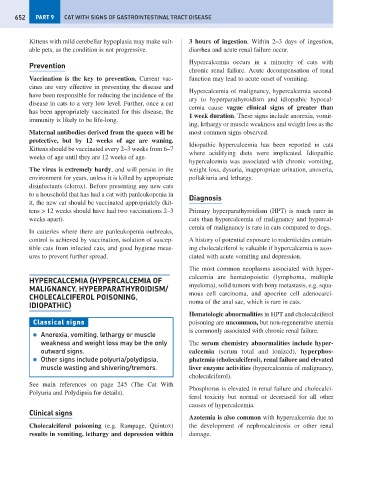Page 660 - Problem-Based Feline Medicine
P. 660
652 PART 9 CAT WITH SIGNS OF GASTROINTESTINAL TRACT DISEASE
Kittens with mild cerebellar hypoplasia may make suit- 3 hours of ingestion. Within 2–3 days of ingestion,
able pets, as the condition is not progressive. diarrhea and acute renal failure occur.
Hypercalcemia occurs in a minority of cats with
Prevention
chronic renal failure. Acute decompensation of renal
Vaccination is the key to prevention. Current vac- function may lead to acute onset of vomiting.
cines are very effective in preventing the disease and
Hypercalcemia of malignancy, hypercalcemia second-
have been responsible for reducing the incidence of the
ary to hyperparathyroidism and idiopathic hypocal-
disease in cats to a very low level. Further, once a cat
cemia cause vague clinical signs of greater than
has been appropriately vaccinated for this disease, the
1 week duration. These signs include anorexia, vomit-
immunity is likely to be life-long.
ing, lethargy or muscle weakness and weight loss as the
Maternal antibodies derived from the queen will be most common signs observed.
protective, but by 12 weeks of age are waning.
Idiopathic hypercalcemia has been reported in cats
Kittens should be vaccinated every 2–3 weeks from 6–7
where acidifying diets were implicated. Idiopathic
weeks of age until they are 12 weeks of age.
hypercalcemia was associated with chronic vomiting,
The virus is extremely hardy, and will persist in the weight loss, dysuria, inappropriate urination, anoxeria,
environment for years, unless it is killed by appropriate pollakiuria and lethargy.
disinfectants (clorox). Before presenting any new cats
to a household that has had a cat with panleukopenia in
Diagnosis
it, the new cat should be vaccinated appropriately (kit-
tens > 12 weeks should have had two vaccinations 2–3 Primary hyperparathyroidism (HPT) is much rarer in
weeks apart). cats than hypercalcemia of malignancy and hypercal-
cemia of malignancy is rare in cats compared to dogs.
In catteries where there are panleukopenia outbreaks,
control is achieved by vaccination, isolation of suscep- A history of potential exposure to rodenticides contain-
tible cats from infected cats, and good hygiene meas- ing cholecalciferol is valuable if hypercalcemia is asso-
ures to prevent further spread. ciated with acute vomiting and depression.
The most common neoplasms associated with hyper-
calcemia are hematopoietic (lymphoma, multiple
HYPERCALCEMIA (HYPERCALCEMIA OF
MALIGNANCY, HYPERPARATHYROIDISM/ myeloma), solid tumors with bony metastasis, e.g. squa-
CHOLECALCIFEROL POISONING, mous cell carcinoma, and apocrine cell adenocarci-
IDIOPATHIC) noma of the anal sac, which is rare in cats.
Hematologic abnormalities in HPT and cholecalciferol
Classical signs poisoning are uncommon, but non-regenerative anemia
is commonly associated with chronic renal failure.
● Anorexia, vomiting, lethargy or muscle
weakness and weight loss may be the only The serum chemistry abnormalities include hyper-
outward signs. calcemia (serum total and ionized), hyperphos-
● Other signs include polyuria/polydipsia, phatemia (cholecalciferol), renal failure and elevated
muscle wasting and shivering/tremors. liver enzyme activities (hypercalcemia of malignancy,
cholecalciferol).
See main references on page 245 (The Cat With
Phosphorus is elevated in renal failure and cholecalci-
Polyuria and Polydipsia for details).
ferol toxicity but normal or decreased for all other
causes of hypercalcemia.
Clinical signs
Azotemia is also common with hypercalcemia due to
Cholecalciferol poisoning (e.g. Rampage, Quintox) the development of nephrocalcinosis or other renal
results in vomiting, lethargy and depression within damage.

